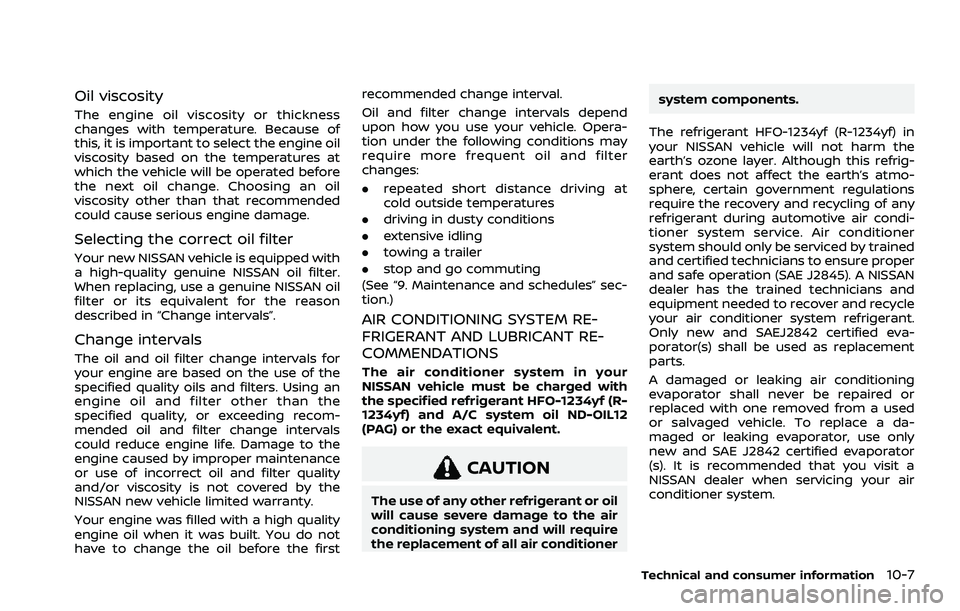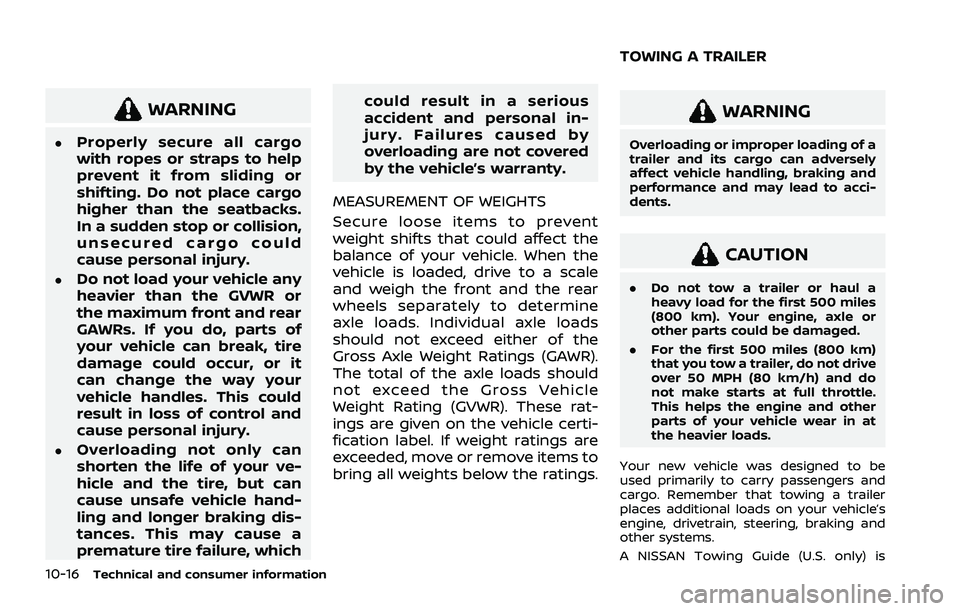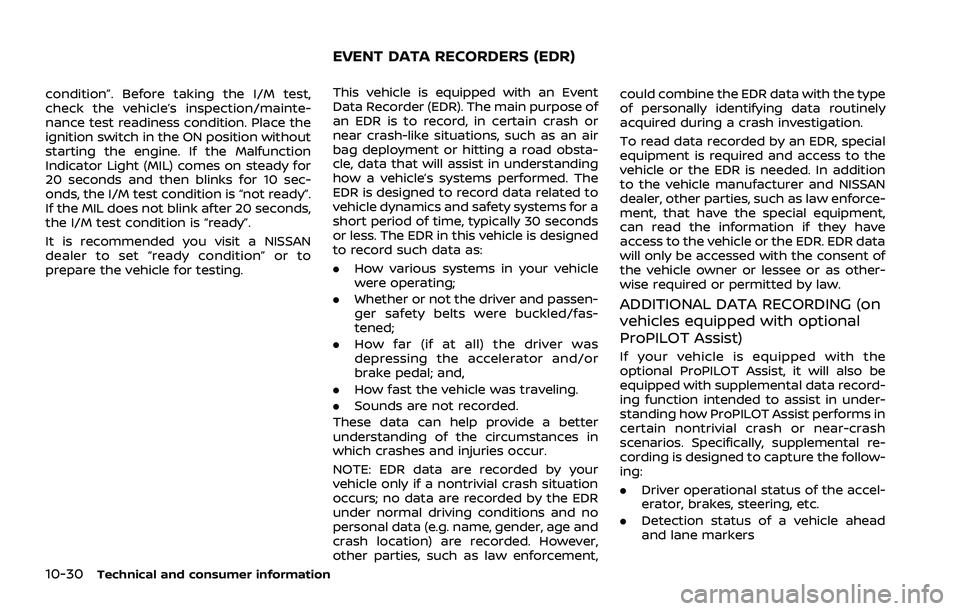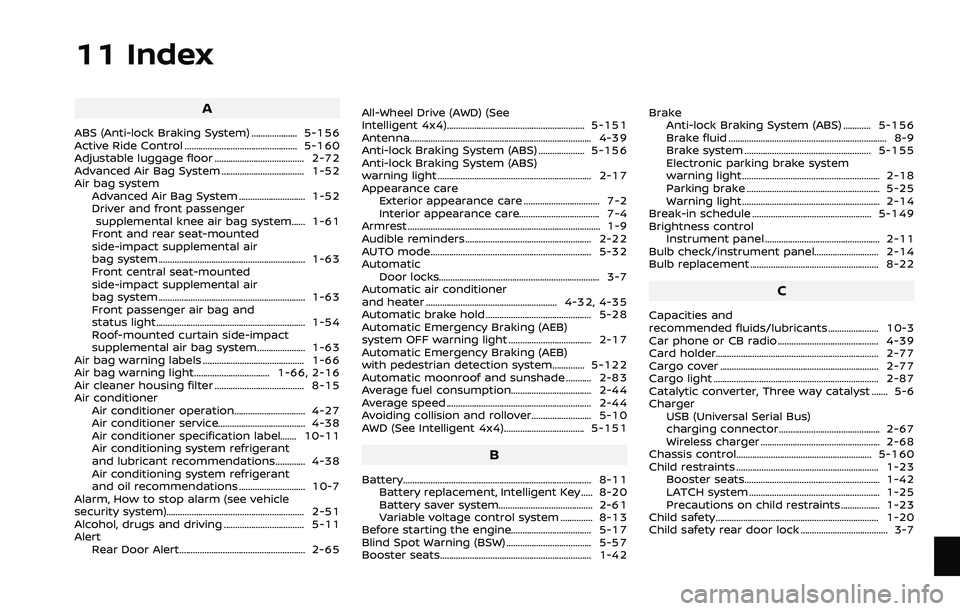engine NISSAN ROGUE 2021 Owner´s Manual
[x] Cancel search | Manufacturer: NISSAN, Model Year: 2021, Model line: ROGUE, Model: NISSAN ROGUE 2021Pages: 556, PDF Size: 2.7 MB
Page 519 of 556

Oil viscosity
The engine oil viscosity or thickness
changes with temperature. Because of
this, it is important to select the engine oil
viscosity based on the temperatures at
which the vehicle will be operated before
the next oil change. Choosing an oil
viscosity other than that recommended
could cause serious engine damage.
Selecting the correct oil filter
Your new NISSAN vehicle is equipped with
a high-quality genuine NISSAN oil filter.
When replacing, use a genuine NISSAN oil
filter or its equivalent for the reason
described in “Change intervals”.
Change intervals
The oil and oil filter change intervals for
your engine are based on the use of the
specified quality oils and filters. Using an
engine oil and filter other than the
specified quality, or exceeding recom-
mended oil and filter change intervals
could reduce engine life. Damage to the
engine caused by improper maintenance
or use of incorrect oil and filter quality
and/or viscosity is not covered by the
NISSAN new vehicle limited warranty.
Your engine was filled with a high quality
engine oil when it was built. You do not
have to change the oil before the firstrecommended change interval.
Oil and filter change intervals depend
upon how you use your vehicle. Opera-
tion under the following conditions may
require more frequent oil and filter
changes:
.
repeated short distance driving at
cold outside temperatures
. driving in dusty conditions
. extensive idling
. towing a trailer
. stop and go commuting
(See “9. Maintenance and schedules” sec-
tion.)
AIR CONDITIONING SYSTEM RE-
FRIGERANT AND LUBRICANT RE-
COMMENDATIONS
The air conditioner system in your
NISSAN vehicle must be charged with
the specified refrigerant HFO-1234yf (R-
1234yf) and A/C system oil ND-OIL12
(PAG) or the exact equivalent.
CAUTION
The use of any other refrigerant or oil
will cause severe damage to the air
conditioning system and will require
the replacement of all air conditioner system components.
The refrigerant HFO-1234yf (R-1234yf) in
your NISSAN vehicle will not harm the
earth’s ozone layer. Although this refrig-
erant does not affect the earth’s atmo-
sphere, certain government regulations
require the recovery and recycling of any
refrigerant during automotive air condi-
tioner system service. Air conditioner
system should only be serviced by trained
and certified technicians to ensure proper
and safe operation (SAE J2845). A NISSAN
dealer has the trained technicians and
equipment needed to recover and recycle
your air conditioner system refrigerant.
Only new and SAEJ2842 certified eva-
porator(s) shall be used as replacement
parts.
A damaged or leaking air conditioning
evaporator shall never be repaired or
replaced with one removed from a used
or salvaged vehicle. To replace a da-
maged or leaking evaporator, use only
new and SAE J2842 certified evaporator
(s). It is recommended that you visit a
NISSAN dealer when servicing your air
conditioner system.
Technical and consumer information10-7
Page 520 of 556

10-8Technical and consumer information
ENGINE
ModelPR25DD
Type Gasoline, 4-cycle, DOHC
Cylinder arrangement 4-cylinder, in-line
Bore × Stroke in (mm)3.504 × 3.937 (89.0 × 100.0)
Displacement cu in (cm
3)151.85 (2,488)
Firing order 1-3-4-2
Idle speed rpm
No adjustment is necessary.
Ignition timing (B.T.D.C.) degree/rpm
Spark plug StandardDXE22H11C
Spark plug gap (Normal) in (mm)0.043 (1.1)
Camshaft operation Timing chain
This spark ignition system complies with the Canadian standard ICES-002.
WHEELS AND TIRES
Road wheel
TypeSize Offset in
(mm)
Conven-
tional 17 × 7.5J 1.57 (40)
18 × 7.5J 1.57 (40)
19 × 7.5J 1.57 (40)
Spare 17 × 4T 1.18 (30)
Tire
Type
SizePressure PSI
(kPa) [Cold]
Con-
ven-
tional 235/65 R17Front: 36
(250)
Rear: 33 (230)
235/60 R18 Front: 33
(230)
Rear: 30 (210)
235/55 R19
Spare T155/80 D17
(2WD)
T165/90 D17
(AWD)
60 (420)
SPECIFICATIONS
Page 521 of 556

DIMENSIONS AND WEIGHTS
Overall length in(mm)182.9 (4,645)*1
183.5 (4,660)*2
Overall width in (mm)72.4 (1,840)
Overall height in (mm)67.9 (1,725)
Front tread in (mm)62.4 (1,585)
Rear tread in (mm)62.6 (1,590)
Wheelbase in (mm)106.5 (2,705)
Gross Vehicle
Weight Rating
(GVWR) lb (kg)
See the F.M.V.S.S. or
C.M.V.S.S. certifica-
tion label on the
driver’s side center
pillar.
Gross Axle
Weight Rating
(GAWR)
Front lb (kg)
Rear lb (kg)
*1: Without license plate
*2: With license plate
When planning to travel in another
country, you should first find out if the
fuel available is suitable for your vehicle’s
engine.
Using fuel with an octane rating that is
too low may cause engine damage. All
gasoline vehicles must be operated with
unleaded gasoline. Therefore, avoid tak-
ing your vehicle to areas where appro-
priate fuel is not available.
When transferring the registration of
your vehicle to another country, state,
province or district, it may be necessary
to modify the vehicle to meet local laws
and regulations.
The laws and regulations for motor
vehicle emission control and safety stan-
dards vary according to the country,
state, province or district; therefore, vehi-
cle specifications may differ.
When any vehicle is to be taken into
another country, state, province or dis-
trict and registered, its modifications,
transportation, and registration are the
responsibility of the user. NISSAN is not
responsible for any inconvenience that
may result.
JVT0352X
VEHICLE IDENTIFICATION NUMBER
(VIN) PLATE
The vehicle identification number plate is
attached as shown. This number is the
identification for your vehicle and is used
in the vehicle registration.
Technical and consumer information10-9
WHEN TRAVELING OR REGISTERING
IN ANOTHER COUNTRYVEHICLE IDENTIFICATION
Page 522 of 556

10-10Technical and consumer information
JVT0253X
VEHICLE IDENTIFICATION NUMBER
(chassis number)
The vehicle identification number is lo-
cated as shown.
WAJ0103X
ENGINE SERIAL NUMBER
The number is stamped on the engine as
shown.
STI0718
F.M.V.S.S./C.M.V.S.S. CERTIFICATION
LABEL
The Federal/Canadian Motor Vehicle
Safety Standards (F.M.V.S.S./C.M.V.S.S.)
certification label is affixed as shown. This
label contains valuable vehicle informa-
tion, such as: Gross Vehicle Weight Rat-
ings (GVWR), Gross Axle Weight Rating
(GAWR), month and year of manufacture,
Vehicle Identification Number (VIN), etc.
Review it carefully.
Page 528 of 556

10-16Technical and consumer information
WARNING
.Properly secure all cargo
with ropes or straps to help
prevent it from sliding or
shifting. Do not place cargo
higher than the seatbacks.
In a sudden stop or collision,
unsecured cargo could
cause personal injury.
.Do not load your vehicle any
heavier than the GVWR or
the maximum front and rear
GAWRs. If you do, parts of
your vehicle can break, tire
damage could occur, or it
can change the way your
vehicle handles. This could
result in loss of control and
cause personal injury.
.Overloading not only can
shorten the life of your ve-
hicle and the tire, but can
cause unsafe vehicle hand-
ling and longer braking dis-
tances. This may cause a
premature tire failure, whichcould result in a serious
accident and personal in-
jury. Failures caused by
overloading are not covered
by the vehicle’s warranty.
MEASUREMENT OF WEIGHTS
Secure loose items to prevent
weight shifts that could affect the
balance of your vehicle. When the
vehicle is loaded, drive to a scale
and weigh the front and the rear
wheels separately to determine
axle loads. Individual axle loads
should not exceed either of the
Gross Axle Weight Ratings (GAWR).
The total of the axle loads should
not exceed the Gross Vehicle
Weight Rating (GVWR). These rat-
ings are given on the vehicle certi-
fication label. If weight ratings are
exceeded, move or remove items to
bring all weights below the ratings.
WARNING
Overloading or improper loading of a
trailer and its cargo can adversely
affect vehicle handling, braking and
performance and may lead to acci-
dents.
CAUTION
. Do not tow a trailer or haul a
heavy load for the first 500 miles
(800 km). Your engine, axle or
other parts could be damaged.
. For the first 500 miles (800 km)
that you tow a trailer, do not drive
over 50 MPH (80 km/h) and do
not make starts at full throttle.
This helps the engine and other
parts of your vehicle wear in at
the heavier loads.
Your new vehicle was designed to be
used primarily to carry passengers and
cargo. Remember that towing a trailer
places additional loads on your vehicle’s
engine, drivetrain, steering, braking and
other systems.
A NISSAN Towing Guide (U.S. only) is
TOWING A TRAILER
Page 529 of 556

available on the website at
www.nissanusa.com. This guide includes
information on trailer towing capability
and the special equipment required for
proper towing.
MAXIMUM LOAD LIMITS
Maximum trailer loads
Never allow the total trailer load to
exceed the value specified in the “Towing
load/specification” (P.10-20) chart found
in this section. The total trailer load
equals trailer weight plus its cargo
weight.
The maximum Gross Combined Weight
Rating (GCWR) should not exceed the
value specified in the following “Towing
Load/Specification” chart.
STI0541
The GCWR equals the combined weight of
the towing vehicle (including passengers
and cargo) plus the total trailer load.
Towing loads greater than these or using
improper towing equipment could ad-
versely affect vehicle handling, braking
and performance.
The ability of your vehicle to tow a trailer
is not only related to the maximum trailer
loads, but also the places you plan to tow.
Tow weights appropriate for level high-
way driving may have to be reduced for
low traction situations (for example, on
slippery boat ramps).
Temperature conditions can also affect
towing. For example, towing a heavytrailer in high outside temperatures on
graded roads can affect engine perfor-
mance and cause overheating. The trans-
mission high fluid temperature and
engine protection mode, which helps
reduce the chance of transmission and
engine damage, could activate and auto-
matically decrease engine power. Vehicle
speed may decrease under high load.
Plan your trip carefully to account for
trailer and vehicle load, weather and road
conditions.
WARNING
Overheating can result in reduced
engine power and vehicle speed.
The reduced speed may be lower
than other traffic, which could in-
crease the chance of a collision. Be
especially careful when driving. If the
vehicle cannot maintain a safe driv-
ing speed, pull to the side of the road
in a safe area. Allow the engine to
cool and return to normal operation.
(See “If your vehicle overheats” (P.6-
13).)
Technical and consumer information10-17
Page 536 of 556

10-24Technical and consumer information
vehicle.
. Determine the overall height of the
vehicle and trailer so the required
clearance is known.
Trailer towing tips
In order to gain skill and an understand-
ing of the vehicle’s behavior, you should
practice turning, stopping and backing up
in an area which is free from traffic.
Steering stability, and braking perfor-
mance will be somewhat different than
under normal driving conditions.
.Always secure items in the trailer to
prevent load shift while driving.
. Lock the trailer hitch coupler with a
pin or lock to prevent the coupler from
inadvertently becoming unlatched.
. Avoid abrupt starts, acceleration or
stops.
. Avoid sharp turns or lane changes.
. Always drive your vehicle at a moder-
ate speed. Some states or provinces
have specific speed limits for vehicles
that are towing trailers. Obey the local
speed limits.
. When backing up, hold the bottom of
the steering wheel with one hand.
Move your hand in the direction in
which you want the trailer to go. Make
small corrections and back up slowly.
If possible, have someone guide you when you are backing up.
Always block the wheels on both vehicle
and trailer when parking. Parking on a
slope is not recommended; however, if
you must do so:CAUTION
If you push the park button to
engage the P (Park) position before
blocking the wheels and applying
the parking brake, transmission da-
mage could occur.
1. Apply and hold the brake pedal.
2. Have someone place blocks on the downhill side of the vehicle and trailer
wheels.
3. After the wheel blocks are in place, slowly release the brake pedal until
the blocks absorb the vehicle load.
4. Apply the parking brake.
5. Push the park button to engage the P (Park) position.
6. Turn off the engine.
To drive away:
1. Apply and hold the brake pedal.
2. Start the engine. 3. Shift the transmission into gear.
4. Release the parking brake.
5. Drive slowly until the vehicle and
trailer are clear from the blocks.
6. Apply and hold the brake pedal.
7. Have someone retrieve and store the blocks.
. While going downhill, the weight of the
trailer pushing on the tow vehicle may
decrease overall stability. Therefore, to
maintain adequate control, reduce
your speed and shift to a lower gear.
Avoid long or repeated use of the
brakes when descending a hill, as this
reduces their effectiveness and could
cause overheating. Shifting to a lower
gear instead provides “engine braking”
and reduces the need to brake as
frequently.
. If the engine coolant temperature
rises to a high temperature, see “If
your vehicle overheats” (P.6-13).
. Trailer towing requires more fuel than
normal circumstances.
. Avoid towing a trailer for your vehicle’s
first 500 miles (800 km).
. For the first 500 miles (800 km) that
you do tow, do not drive over 50 MPH
(80 km/h).
Page 537 of 556

.Have your vehicle serviced more often
than at intervals specified in the
recommended maintenance schedule
shown in the "9. Maintenance and
schedules" section.
. When making a turn, your trailer
wheels will be closer to the inside of
the turn than your vehicle wheels. To
compensate for this, make a larger
than normal turning radius during the
turn.
. Crosswinds and rough roads will ad-
versely affect vehicle/trailer handling,
possibly causing vehicle sway. When
being passed by larger vehicles, be
prepared for possible changes in
crosswinds that could affect vehicle
handling.
Do the following if the trailer begins to
sway:
1. Take your foot off the accelerator pedal to allow the vehicle to coast
and steer as straight ahead as the
road conditions allow. This combina-
tion will help stabilize the vehicle.
.Do not correct trailer sway bysteering or applying the brakes.
2. When the trailer sway stops, gently apply the brakes and pull to the side
of the road in a safe area. 3. Try to rearrange the trailer load so it is
balanced as described earlier in this
section.
. Be careful when passing other vehi-
cles. Passing while towing a trailer
requires considerably more distance
than normal passing. Remember the
length of the trailer must also pass the
other vehicle before you can safely
change lanes.
. Downshift the transmission to a lower
gear for engine braking when driving
down steep or long hills. This will help
slow the vehicle without applying the
brakes.
. Avoid holding the brake pedal down
too long or too frequently. This could
cause the brakes to overheat, result-
ing in reduced braking efficiency.
. Increase your following distance to
allow for greater stopping distances
while towing a trailer. Anticipate stops
and brake gradually.
. NISSAN recommends that the cruise
control not be used while towing a
trailer.
. While towing a trailer, do not use the
following systems (if so equipped):
— Lane Departure Warning (LDW) sys-
tem — Intelligent Lane Intervention (I-LI)
system
— Blind Spot Warning (BSW) system
— Intelligent Blind Spot Intervention (I-BSI) system
— Rear Cross Traffic Alert (RCTA) sys- tem
— ProPILOT Assist system (Intelligent Cruise Control (ICC), ProPILOT As-
sist with Navi-link and Steering
Assist)
— Automatic Emergency Braking (AEB) with pedestrian detection
system
— Intelligent Forward Collision Warn- ing (I-FCW) system
— Rear Automatic Braking (RAB) sys- tem
. Some states or provinces have speci-
fic regulations and speed limits for
vehicles that are towing trailers. Obey
the local speed limits.
. Check your hitch, trailer wiring har-
ness connections, and trailer wheel
lug nuts after 50 miles (80 km) of
travel and at every break.
. When launching a boat, do not allow
the water level to go over the exhaust
tail pipe or rear bumper.
. Make sure you disconnect the trailer
lights before backing the trailer into
Technical and consumer information10-25
Page 542 of 556

10-30Technical and consumer information
condition”. Before taking the I/M test,
check the vehicle’s inspection/mainte-
nance test readiness condition. Place the
ignition switch in the ON position without
starting the engine. If the Malfunction
Indicator Light (MIL) comes on steady for
20 seconds and then blinks for 10 sec-
onds, the I/M test condition is “not ready”.
If the MIL does not blink after 20 seconds,
the I/M test condition is “ready”.
It is recommended you visit a NISSAN
dealer to set “ready condition” or to
prepare the vehicle for testing.This vehicle is equipped with an Event
Data Recorder (EDR). The main purpose of
an EDR is to record, in certain crash or
near crash-like situations, such as an air
bag deployment or hitting a road obsta-
cle, data that will assist in understanding
how a vehicle’s systems performed. The
EDR is designed to record data related to
vehicle dynamics and safety systems for a
short period of time, typically 30 seconds
or less. The EDR in this vehicle is designed
to record such data as:
.How various systems in your vehicle
were operating;
. Whether or not the driver and passen-
ger safety belts were buckled/fas-
tened;
. How far (if at all) the driver was
depressing the accelerator and/or
brake pedal; and,
. How fast the vehicle was traveling.
. Sounds are not recorded.
These data can help provide a better
understanding of the circumstances in
which crashes and injuries occur.
NOTE: EDR data are recorded by your
vehicle only if a nontrivial crash situation
occurs; no data are recorded by the EDR
under normal driving conditions and no
personal data (e.g. name, gender, age and
crash location) are recorded. However,
other parties, such as law enforcement, could combine the EDR data with the type
of personally identifying data routinely
acquired during a crash investigation.
To read data recorded by an EDR, special
equipment is required and access to the
vehicle or the EDR is needed. In addition
to the vehicle manufacturer and NISSAN
dealer, other parties, such as law enforce-
ment, that have the special equipment,
can read the information if they have
access to the vehicle or the EDR. EDR data
will only be accessed with the consent of
the vehicle owner or lessee or as other-
wise required or permitted by law.
ADDITIONAL DATA RECORDING (on
vehicles equipped with optional
ProPILOT Assist)
If your vehicle is equipped with the
optional ProPILOT Assist, it will also be
equipped with supplemental data record-
ing function intended to assist in under-
standing how ProPILOT Assist performs in
certain nontrivial crash or near-crash
scenarios. Specifically, supplemental re-
cording is designed to capture the follow-
ing:
.
Driver operational status of the accel-
erator, brakes, steering, etc.
. Detection status of a vehicle ahead
and lane markers
EVENT DATA RECORDERS (EDR)
Page 547 of 556

11 Index
A
ABS (Anti-lock Braking System) .................... 5-156
Active Ride Control ................................................. 5-160
Adjustable luggage floor ....................................... 2-72
Advanced Air Bag System .................................... 1-52
Air bag systemAdvanced Air Bag System ............................. 1-52
Driver and front passengersupplemental knee air bag system...... 1-61
Front and rear seat-mounted
side-impact supplemental air
bag system................................................................ 1-63
Front central seat-mounted
side-impact supplemental air
bag system................................................................ 1-63
Front passenger air bag and
status light................................................................. 1-54
Roof-mounted curtain side-impact
supplemental air bag system..................... 1-63
Air bag warning labels ............................................ 1-66
Air bag warning light................................. 1-66, 2-16
Air cleaner housing filter ....................................... 8-15
Air conditioner Air conditioner operation............................... 4-27
Air conditioner service...................................... 4-38
Air conditioner specification label....... 10-11
Air conditioning system refrigerant
and lubricant recommendations............. 4-38
Air conditioning system refrigerant
and oil recommendations ............................. 10-7
Alarm, How to stop alarm (see vehicle
security system)............................................................ 2-51
Alcohol, drugs and driving ................................... 5-11
Alert Rear Door Alert....................................................... 2-65 All-Wheel Drive (AWD) (See
Intelligent 4x4)............................................................ 5-151
Antenna........................................................................\
....... 4-39
Anti-lock Braking System (ABS) .................... 5-156
Anti-lock Braking System (ABS)
warning light ................................................................... 2-17
Appearance care
Exterior appearance care ................................. 7-2
Interior appearance care................................... 7-4
Armrest ........................................................................\
............ 1-9
Audible reminders....................................................... 2-22
AUTO mode...................................................................... 5-32
Automatic Door locks...................................................................... 3-7
Automatic air conditioner
and heater ......................................................... 4-32, 4-35
Automatic brake hold .............................................. 5-28
Automatic Emergency Braking (AEB)
system OFF warning light .................................... 2-17
Automatic Emergency Braking (AEB)
with pedestrian detection system.............. 5-122
Automatic moonroof and sunshade ........... 2-83
Average fuel consumption................................... 2-44
Average speed ............................................................... 2-44
Avoiding collision and rollover.......................... 5-10
AWD (See Intelligent 4x4)................................... 5-151
B
Battery........................................................................\
.......... 8-11 Battery replacement, Intelligent Key ..... 8-20
Battery saver system......................................... 2-61
Variable voltage control system .............. 8-13
Before starting the engine................................... 5-17
Blind Spot Warning (BSW) ..................................... 5-57
Booster seats.................................................................. 1-42 Brake
Anti-lock Braking System (ABS) ............ 5-156
Brake fluid ..................................................................... 8-9
Brake system ....................................................... 5-155
Electronic parking brake system
warning light ............................................................ 2-18
Parking brake .......................................................... 5-25
Warning light............................................................ 2-14
Break-in schedule .................................................... 5-149
Brightness control Instrument panel .................................................. 2-11
Bulb check/instrument panel............................ 2-14
Bulb replacement ........................................................ 8-22
C
Capacities and
recommended fluids/lubricants...................... 10-3
Car phone or CB radio ............................................ 4-39
Card holder....................................................................... 2-77
Cargo cover ..................................................................... 2-77
Cargo light ........................................................................\
2-87
Catalytic converter, Three way catalyst ....... 5-6
Charger USB (Universal Serial Bus)
charging connector............................................ 2-67
Wireless charger .................................................... 2-68
Chassis control........................................................... 5-160
Child restraints .............................................................. 1-23 Booster seats........................................................... 1-42
LATCH system ......................................................... 1-25
Precautions on child restraints................. 1-23
Child safety....................................................................... 1-20
Child safety rear door lock ...................................... 3-7